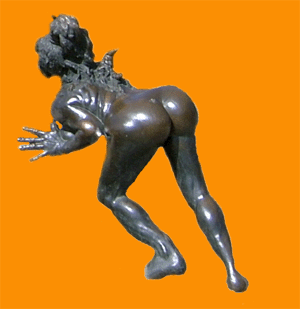April 30
Now to the Brocken the witches ride;
the stubble is gold and the corn is green;
There is the carnival crew to be seen,
And Squire Urianus will come to preside.
So over the valleys our company floats,
with witches a-farting on stinking old goats.

Exactly six months before Halloween, the Germans and Scandinavians celebrate Walpurgis Night, May-Eve, Beltane, or Hexennacht, aka Witches’ Night.
According to legend, on the last night of April, witches would meet at Hexentazplatz (Witches’ Dancing Place, conveniently named in case you got lost and had to ask a tourist) near the town of Thale in northern Germany. From there they would fly upon broomsticks to the highest point in the Harz Mountains, a summit called “The Brocken.”

At the Brocken there they would dance with the devil, a horned he-goat demon named Lord Urian, who would grant them mystical powers…for a price. Scarier than even the orgiastic rituals of Walpurgis Night, is the unholy marriage of Google-translation and the German language in describing this event:
“On the chunk of dance legend after all witches in a large circle around the fire and then the devil kiss the butt. Then you can have with the devil marry and receive from him magic powers.”
Don’t be Frightened!
OK, be a little frightened. For centuries, tales spread of sordid revels atop the Harz Mountains. To this day, the Brocken is haunted by the spirits of angry tourists who felt cheated having yet to encounter a single supernatural event.
There are many reasons this mountaintop became synonymous with the dark legends of Deutschland. Its inaccessible height and remote location for one—okay, that’s two actually. Also, the region wasn’t settled until after 1000 AD. (That’s the German equivalent of 1950 in America.) And perhaps most important, the Brocken is the site of an unusual and eerie optical illusion known as the Brockengenspenst, or the “Brocken spector.”
“As the sun sinks, the shadow of a walker cast from a ridge becomes magnified and an enormous silhouette appears on low-lying clouds or mist banks below the mountain. Although it’s only a shadow, the distant “specter” appears to be walking at the same pace, doggedly tracking the observer’s path.”
— Season of the Witch – Walpurgisnacht in Germany’s Harz Mountains

In other words, in the centuries before the meteorological sciences, many a Brocken hiker were spooked by their own shadows. At least one visitor was literally frightened to death.
Germany may not have been the birthplace of the witch, but it did propagate the image of the witch as we know it today, through its literature, legends, and its ‘litigation’:
“Between 1623 and 1633, the prince-bishops of two Bavarian towns, Wƒrzburg and Bamburg, ordered the burning of at least fifteen hundred “witches” between them. The victims of Wƒrzburg’s bishop included his own nephew, nineteen priests, and a child aged seven. One reason why medieval Germany developed an obsession with stamping out “witchcraft” may lie in the food that was being eaten. If the weather is warm and damp, rye (then a staple crop) can produce a poisonous fungus called ergot. Hallucinations, fits, pinpricking sensations, muscle spasms: the symptoms of ergotism are similar to the effects of LSD, which itself is derived from ergot.”
Walpurgis got its name from an 8th century saint. Walpurgis had nothing to do with witches, but April 30 was her feast day. In the Church’s effort to Christianize Germany’s tenacious pagan roots, they made Walpurgis Night about Walpurgis’ fight with the dark forces of paganism.
Yet still the pagan rituals continue to this day…
Walpurgis Night, the time is right
The ancient powers awake.
So dance and sing, around the ring
And Beltane magic make.
—Doreen Valiente, Witchcraft for Tomorrow
Brocken “Money” – a tourist gimmick from the 1920s
Brocken postcard collection from the late 19th/early 20th century.




Jawohl, great stuff!
At U. of M. I had an entire semester course devoted to Goethe’s Faust. But we never learned all the interesting things you offer here. Thanks!
I haven’t read Faust, but your comment made me look further into it. Apparently…
“The chronology of certain scenes of the Gretchen tragedy in Goethe’s Faust, especially the ‘Walpurgisnacht’ scene, is, according to the opinion of many critics, very much confused…here is the dramatic justification for the whole ‘Walpurgisnacht’ scene. The whirlwind of lewdness was needed to bring back to Faust’s memory the pure and noble emotions of his former love. While he is dancing with the naked witches, he has the vision of Gretchen in her misery. “ Modern language notes 21 – Johns Hopkins University. Friedrich Wehse
If you’ve read it, hopefully you know what he’s talking about. Me, I’ll have to read it!
Also, according to one observer as far back as the 1850’s…
“Had Goethe never written ‘Faust’ the Brocken would probably have slumbered amid its woods as wild and as solitary as when the Doctor and the fiend climbed its sides. Now the poem makes the mountains renowned; its renown brings strangers from all lands to visit it…”
The German Harz, James M Hoffin, from The Knickerbocker, March 1850
Bei uns in Braunlage ist auch wieder richtig was los. In der Nacht zum 1. Mai fliegen wieder die Hexen durch die Luft. Ein Video seht Ihr hier: http://www.harzidyll.de/veranstaltungen-harz-braunlage.html